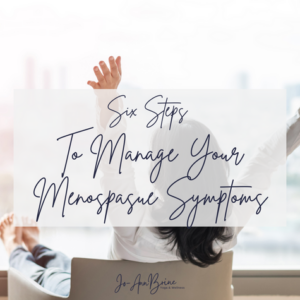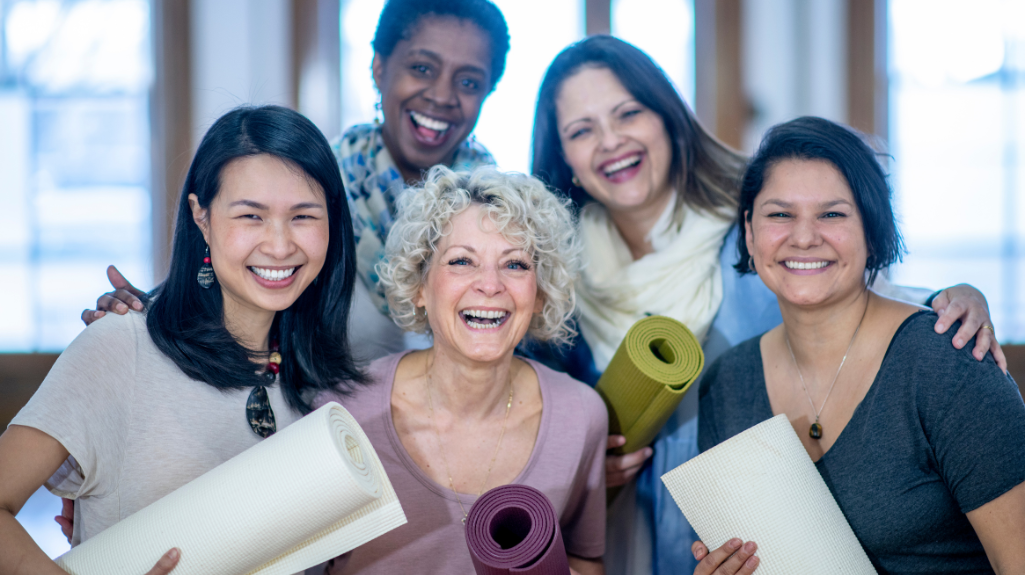
by Jo-Ann Brine | Menopause, Midlife, Perimenopause, Yoga |
Is exercise really that important for midlife women? Who has time for that??
YES! The answer is a resounding YES!
Exercise is important for people of all ages, but it becomes even more critical for women in midlife. Women in their 40s and 50s may begin to experience a variety of physical and hormonal changes that can negatively impact their health and well-being. Fun, right? It’s not all doom and gloom, though because exercise can help mitigate the results and symptoms that come along with some of these changes and improve overall health. The key is to be doing exercise that works with your body, and not against it.
Let’s dive in!

One of the most significant changes women in midlife experience is a decrease in estrogen levels. This decrease can lead to a range of symptoms, including hot flashes, night sweats, and vaginal dryness. And guess what? Exercise can help manage these symptoms!
Midlife women are also at a higher risk for other health conditions, including heart disease, osteoporosis, and type 2 diabetes. Exercise can help reduce the risk of developing these conditions by improving cardiovascular health, increasing bone density, and regulating blood sugar levels.
Regular exercise can also help midlife women maintain a healthy weight. As women age, their metabolism slows down, making it more challenging to maintain a healthy weight.
Good nutrition can help here too, but that’s a topic for another day 😀
Beyond the physical benefits, regular exercise can also improve mental health and cognitive function. Studies have shown that regular exercise can reduce the risk of depression and anxiety, improve memory and concentration, and increase overall cognitive function.
You may be wondering if there are specific exercises that are better for midlife women and the answer is YES!
Here are my suggestions for what to include in your exercise “routine”
Strength/Resistance Training
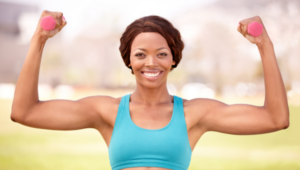
Strength training is first on my list as it’s the most important and one that we midlife women neglect. We lose muscle mass as we age and we need strength/resistance training to prevent this from happening. Using weights, resistance bands, or bodyweight exercises, can help improve bone density, maintain muscle mass, and boost metabolism. Aim for two full-body strength/resistance sessions per week, targeting major muscle groups like the legs, arms, chest, back, and core.
TIP: Start by doing squats without weights and gradually work up to adding weight or resistance bands. Try push-ups at the wall and as you get stronger, lower the incline to a counter, then to a bench, and finally to the floor.
Cardiovascular Exercise
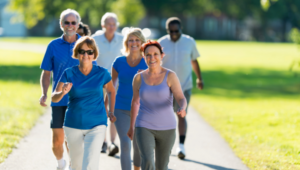
Cardiovascular exercise, such as walking, cycling, swimming, or dancing, can help improve heart health, reduce the risk of chronic diseases, and maintain a healthy weight. Aim for 2 or 3 30-45 minutes sessions of low/moderate-intensity cardio exercise per week. Don’t overdo it here, ladies. Get outside if you can.
TIP: Take short 5-10 minute walk breaks during your day. It all adds up 🙂
Flexibility
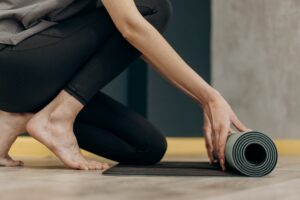
Flexibility exercises like stretching, yoga, pilates, or tai chi can help improve range of motion, reduce the risk of injury, and improve posture. Aim for at least two flexibility sessions per week or better yet, add a daily yoga routine to your repertoire. Short sessions more often can be better than fewer long sessions per week. 10 minutes a day is all you need but be warned, you may want to do more 😉
TIP: If you sit at a desk all day, take regular stretching breaks. Your body will thank you for it.
Mobility
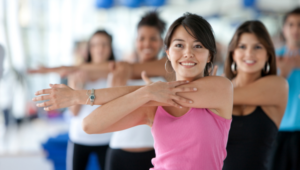
Mobility exercises are essential for midlife women to maintain flexibility, joint health, and overall physical function. As we age, our joints can become stiffer, and our range of motion can decrease. Mobility exercises can help maintain and improve joint health, reduce the risk of injury, and improve posture. Some examples of mobility exercises for midlife women are:
- Shoulder rolls
- Arm circles
- Ankle circles
- Hip circles
- Twists
TIP: Incorporate these moves into a warm-up or cool-down. Many mobility moves will already be included in a yoga class.
Balance

Balance exercises, such as standing on one foot, walking heel to toe, or doing balance poses in yoga, can help reduce the risk of falls and improve overall balance. A bonus of balance work is that it also works the core!
TIP: Try standing on one foot while standing in line at the grocery store. Or do a tree pose and see what kind of looks you get 😜
High-Intensity Interval Training
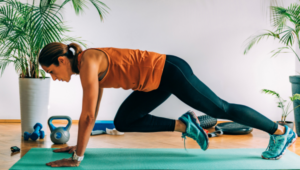
High-Intensity Interval training (HIIT) is a form of exercise that involves short bursts of high-intensity exercise followed by periods of rest. It can help improve cardiovascular health, increase metabolism, and burn calories in a short amount of time. However, it may not be suitable for everyone, especially those with certain health conditions or injuries. Try to keep HIIT to 45 minutes total per week, broken up into a minimum of 2 sessions.
TIP: Don’t complicate it. Make the exercise simple but intense enough to get the heart rate up.
Overall, exercise is essential for midlife women to maintain their health and well-being. Incorporating regular physical activity into their daily routine can help manage symptoms of menopause, reduce the risk of chronic conditions, maintain a healthy weight, and improve mental health and cognitive function. Bonus – Exercise also helps improve sleep when done early in the day…zzzzz!
Need some help getting started?
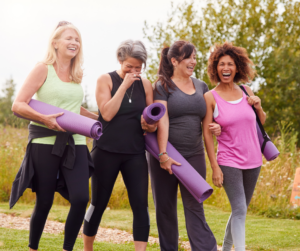
If you would like some guidance on what to do and how to incorporate more movement into your day, I invite you to check out my upcoming 7-day yoga/movement challenge for midlife women – CLICK HERE

by Jo-Ann Brine | Midlife |
Why are women in midlife so stressed? I bet you think I’m going to say menopause. Or Hormones. Am i right?
Wrong. For once, the answer isn’t hormones.
Why DO midlife women have stress?

People say adolescence is tough. But midlife is when spit really hits the fan for women. Here are the real reasons we’re so stressed:
- Increased responsibilities at work.
- Relationships breaking down.
- New Relationships.
- Blended Families.
- Launching kids.
- Serious health diagnoses.
- Financial insecurity.
- Caring for aging parents.
These were all reasons given by women participating in a 23-year study about what causes stress in middle age.
Only four of 81 women mentioned menopause as a challenge.
The study concluded:
“Women found themselves searching for balance in the midst of multiple co-occurring stressors while coping with losses and transitions, for some in a context of limited resources.”
Basically, we’re juggling too many things with not enough arms.
What’s the result of all this stress?

Chronic stress weakens your immune system.
Your body copes with stress by releasing epinephrine and cortisol. When these hormones are present all the time, plaque builds up on your artery walls putting you at greater risk of stroke.
When your body is constantly in survival mode, it never gets a chance to look after basic upkeep.
So does Menopause cause stress?
No.
Menopause doesn’t cause stress. Stress stops your body from managing menopause.
What?
After menopause, our ovaries stop producing estrogen. When that happens, our adrenal glands are supposed to pick up the slack by producing small amounts of estrogen and progesterone.
Unfortunately, they can’t do this job if they’re busy producing cortisol – the stress hormone.
The adrenal glands have to assume you’re using the stress hormones to run from tigers, which is more important than fertility.
Reduce your stress, and your menopause symptoms are likely to subside.
How does Yoga reduce Midlife Stress?

Yoga is particularly good for the kind of stress middle-aged women experience. I.e. juggling priorities and worries on little sleep.
That’s because yoga gives your body and mind opportunities to practice juggling in a safe environment.
Sensations are temporary (and so is everything else)

Think of a pose you find really hard – say twisted chair pose.
Your thighs and glutes are burning. Your teeth keep clenching. You just want it to be over.
And then…it’s over.
Putting your body through short periods of stress helps you learn that difficulties are temporary.
Focus on breathing calmly, unclench your teeth, and trust that this negative feeling or incident will pass eventually.
Yoga boosts confidence
When your kid/partner/co-worker is sick, do you think:
- My whole day is ruined. Nothing is getting done today.
- This sucks. What’s the best way to manage it?
Either way, you’re dealing with an unexpected obstacle. But the second response feels less stressful.
The more confidence you have in your ability to overcome obstacles, the less they stress you out.
Practicing the Yoga Pose You Hate
Say your yoga teacher asks everyone to do a side plank, and you worry you won’t be able to manage it. You groan. You swear you won’t be able to do it.
And then surprise! You hold it for a few seconds longer than you thought. Or you figure out a way to do it on your elbow or with a leg out as a “kickstand.”
Yes! You proved yourself wrong! You were able to figure out a way to do side plank after all.
And if you were able to figure out side plank, then maybe you’ll be able to get your report done with a sick kid/co-worker/partner after all. Maybe there’s a “kickstand” for that too.
Focus on the present moment

Something that often gets in the way of practicing yoga regularly is worrying that they don’t have the energy or strength to get through the whole class.
But when we decide to focus on the strength or energy we need for one moment at a time, it becomes much easier.
First, we just try to get to the mat with our yoga clothes on and our water bottle ready.
Instead of worrying about the standing poses to come, we focus solely on the warm up.
Every time you catch yourself worrying about the whole class at once, stop. Ask yourself what you need to focus on right now.
Maybe you’ll find that, pose by pose, you did get through the whole class after all.
Maybe you’re really not feeling at your best today and you decide to quit after half an hour.
But for that half-hour you were totally focused on what you were doing.
A totally focused half-hour of warm ups and seated stretches is way more valuable than 30 minutes of going through motions while you pre-planned dinner and worried about the report you didn’t finish. In the second scenario, nothing gets your full attention.
Commit to focusing on the present task in your yoga practice, and I guarantee you’ll get better at focusing on one task at a time in your daily life too.
How to practice Yoga for Midlife Stress

How often and how much?
Two to four times a week would be amazing. But you know what? Once a week is still great.
Don’t make yoga a new thing to stress about.
What kind of yoga is best for midlife stress?
Restorative yoga is great for winding down from a stressful day. Choose this style when you just want to relax.
For long-term stress reduction, I’d recommend a hatha or vinyasa class. These classes train the body to feel stress and then come back to base.
You activate the sympathetic nervous system when you do challenging postures, like standing poses and balances.
Seated and supine postures, like forward fold and revolved belly twist, activate the parasympathetic nervous system.
Need more inspiration?
Join my yoga membership for a library full of practices, and monthly live class together.
Don’t forget Breathwork.

One of the biggest reasons yoga is such a great stress reliever is because of the focus on breath.
Even just paying attention to your breath can be enough to calm your heart rate.
Why?
Because your breath is always happening in the present moment. So if you’re focused on your breath, you’re automatically not thinking about the million other things you have to do today.
Extended exhale
This is the easiest trick there is for switching your body from fight or flight to rest and digest.
Simply make your out breath last a second or two longer than your in breath.
Count, if that helps. See how long it takes to get to the top of your normal inhale. Breathe out for an extra count or two longer.
Use this method when you’re feeling stressed, or when you’re trying to fall asleep.
Meditation is excellent for reducing stress

Think of all your your thoughts and emotions as weather – rain, wind, hail, fog.
Your mind is the sky. Weather patterns come and go, but the sky is constant.
Meditation is a way of looking beyond the weather to the part of your mind that’s constant.
If you never practice meditation, you might fall into a trap of thinking that you are a bundle of anger/anxiety/judgment/sadness. You’re not.
Your mind may be experiencing all those feelings and thoughts. But they are as temporary as weather. No matter how hard the wind blows, the sky never falls.
Is Yoga A Match for MidLife Stress?
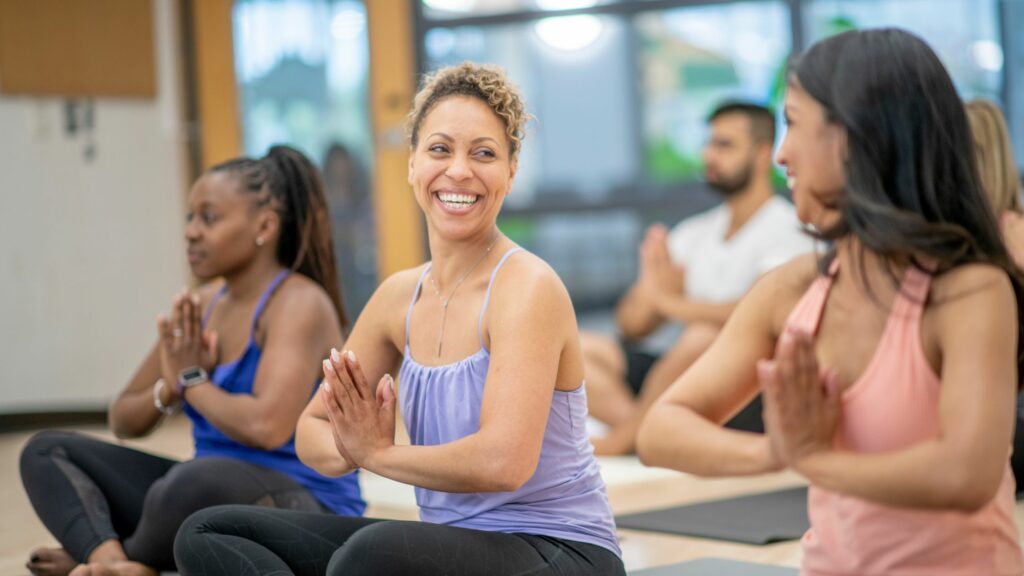
The truth is, we have a lot to be stressed about. It’s not just one thing. And that means we can’t just take hormone replacements, or vitamins to fix it. And we can’t cut all the sources of stress out of our lives, because it’s coming from all sides.
That’s why I’d argue that yoga is the best answer. It’s not just physical exercise. It’s a method of training our minds and bodies to be okay with stress.
In effect, yoga upgrades our skills to match our opponent. When we have the confidence that we can handle whatever comes, our stress naturally reduces.
More Yoga for Stress Tips?
Do you need regular motivation to stick to a yoga practice? Join my yoga membership for a mix of live and video classes every month.
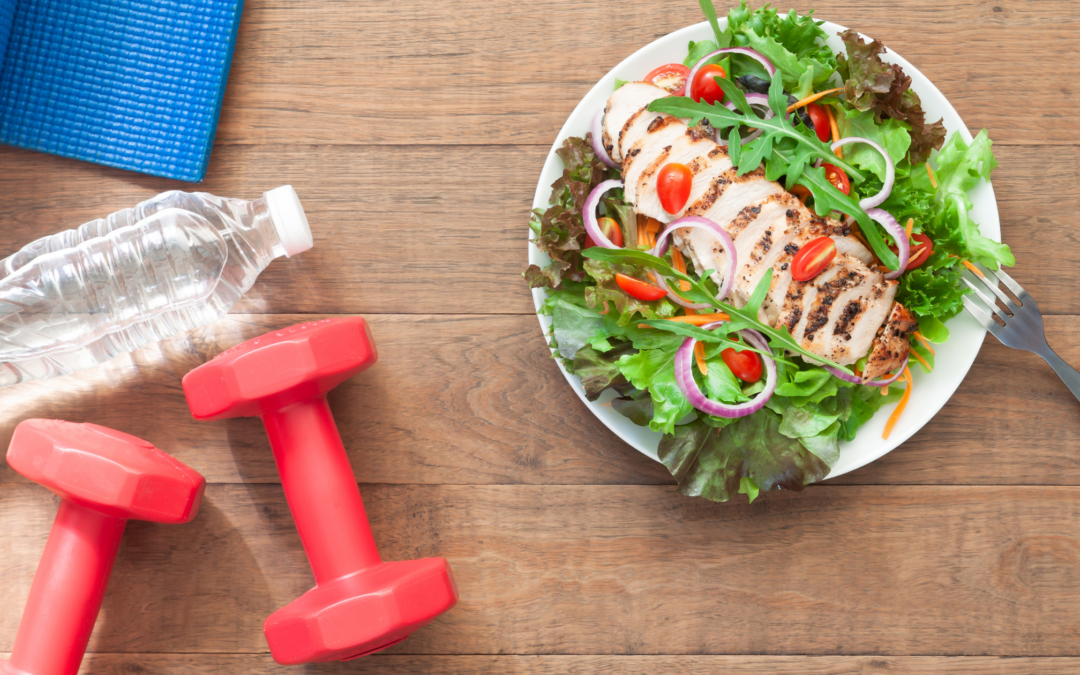
by Jo-Ann Brine | Menopause, Midlife, Perimenopause |
I’m often asked how important exercise and nutrition are with respect to their effects on our “menopausal” symptoms and overall health. The short answer is VERY IMPORTANT…allow me to elaborate.
Here are a few ways exercise can help:
- Reduce hot flashes: Exercise has been shown to reduce the frequency and intensity of hot flashes in menopausal women. Yay!
- Improves bone density: Regular weight-bearing exercise can help maintain and improve bone density, which can decrease the risk of osteoporosis.
- Improves mood and reduces stress and anxiety: Exercise has been shown to improve mood and reduce anxiety in menopausal women.
- Improves cardiovascular health: Exercise can help lower blood pressure, reduce the risk of heart disease, and improve overall cardiovascular health.
It’s important to stay active and engage in regular physical activity, which can help support bone health and maintain muscle mass. Be sure to incorporate strength/resistance training in your exercise plan. Make sure you are doing the right type of exercise as well as the right amount for your midlife body. While we know exercise is good for our health, there is the potential of too much of a good thing, especially when it comes to cardio.
The importance of Nutrition:
- Helps manage weight: Proper nutrition can help women maintain a healthy weight during perimenopause, menopause, and post-menopause.
- Improves bone health: A diet rich in calcium, vitamin D, and other bone-healthy nutrients can help maintain and improve bone density.
- Reduces the risk of chronic diseases: A healthy diet can help reduce the risk of chronic diseases such as heart disease, diabetes, and cancer.
- Reduces hot flashes: Certain foods, such as soy products and flaxseed, may help reduce the frequency and intensity of hot flashes in menopausal women. Yes, please!
Overall, a healthy and balanced diet for perimenopausal women should focus on whole, nutrient-dense foods and limit processed and high-sugar foods.
Here are some guidelines for a healthy and balanced diet for perimenopausal women:
- Eat your veggies…and lots of them! They are rich in vitamins, minerals, and fiber, which can help support overall health and reduce the risk of chronic diseases. Especially leafy greens and cruciferous veggies like broccoli and cauliflower.
- Whole grains: These are a good source of fiber and can help regulate blood sugar levels, which can be important during perimenopause when insulin resistance may be increased.
- Prioritize protein: Protein is important for maintaining muscle mass and supporting bone health, both of which can be affected during perimenopause. Choose lean sources of protein such as poultry, fish, tofu, and legumes. Try to get a serving of protein at each meal.
- Incorporate healthy fats: Omega-3 fatty acids are important for brain health, can help reduce inflammation and improve heart health. Good sources of omega-3s include fatty fish, flaxseeds, chia seeds, and walnuts.
- Incorporate phytoestrogen-rich foods: Phytoestrogens are plant compounds that mimic estrogen in the body. They can help alleviate hot flashes and other menopausal symptoms. Foods rich in phytoestrogens include soybeans, tofu, tempeh, flaxseeds, sesame seeds, and whole grains.
- Avoid processed foods: These often contain high amounts of added sugars, salt, and unhealthy fats, which can increase the risk of chronic diseases and exacerbate symptoms of perimenopause.
- Limit alcohol and caffeine intake: Sorry, ladies…both can disrupt sleep and exacerbate symptoms such as hot flashes and mood changes.
Want more tips and encouragement for managing your menopause symptoms? Download your 6-Step Guide right here!

by Jo-Ann Brine | Midlife |
If you’re having trouble getting the rest you so richly deserve, you’re not alone! 40% of women have sleep problems during perimenopause and menopause. What’s at fault? There are six main culprits. But don’t despair. You can beat them with my best sleep tips for women in midlife, including yoga, meditation, and pranayama.
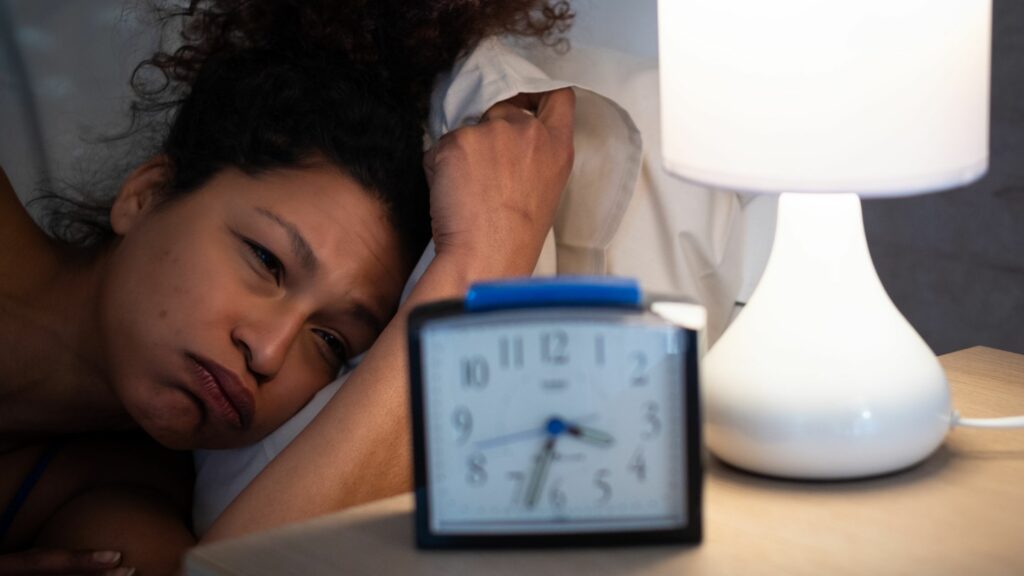
Why is it harder to sleep as we get older?
Why do so many middle-aged and older women have insomnia? Here are six common culprits.
Hot flashes / Night Sweats
You’re having a lovely sleep, not bothering anyone, when suddenly the blood vessels at the skin’s surface expand. Your skin flushes red, and your body is unbearably hot. To cool down, your body turns on the taps, i.e. your sweat glands.
Now you’re hot and wet (and not in a sexy way). Followed by cold and damp. Yuck!
Sometimes multiple times a night! For years!
Grrrrr!
Depression / Anxiety
Depression and anxiety are extremely common for women in mid-life. Many of us are reflecting back on the past, sometimes a little too critically. At the same time, we’re also super busy with work, kids, ageing parents, and community responsibilities.
The nasty combination of worry and self-judgement makes it really tough to fall asleep and stay that way.
The Perimenopause Roller Coaster
Hormones play a big role in the type of sleep you get. The week before your period can be the worst during perimenopause because your progesterone levels are so high.
Progesterone interferes with deep, slow-wave sleep. So in that week before your period, you wake up many times throughout the night for a few seconds.
Aches and Pains
Hormones don’t get all the credit. Let’s not forget all the other complaints that come with ageing.
- Joint pain,
- Chronic pain
- Restless legs
- Indigestion
Anyone of these can have you stomping to the couch in the middle of the night.
Ageing Sleep Patterns
As we age, a protein called beta amyloid gradually builds up in the brain. The more of this protein the less likely that we reach the deeper sleep states. After age 60, we can expect to wake three to four times each night!
Need to Pee!
And the biggest reason we’re not getting enough sleep: going to the bathroom a million times a night!
No scientific studies needed here. Unfortunately, I have all the proof I need.
Sleep Tips for Midlife Women

Darkness
Darkness signals your body that it’s time to rest. If your body isn’t getting the signal, you may need to turn down the lights even further.
- Get black out curtains to block light from neighbours and street lights.
- Wear an eye mask.
- Avoid watching television, scrolling on your phone, or reading on tablets for at least an hour before bed. The blue lights from screens could be interrupting those important darkness signals.
Cool Rooms
Our bodies naturally cool down right before we fall asleep. Colder temperatures stimulate our bodies to release more melatonin – essential for sleep.
So an hour before bed, try turning down your thermostat or cracking a window.
Last Call
Caffeine
Cut yourself off after lunch if you can, and reduce your overall intake.
Alcohol
Same goes for alcohol. A glass of wine feels relaxing in the moment. But drinking before bed tends to result in anxious dreams and a panicked wake-up about 2am.
Snacks
Buttery popcorn, greasy pizza slices, and rich brownies can come back to haunt you. Avoid heartburn by limiting evening snacking.
Fluids
Stop drinking all fluids a few hours before bed to cut down on trips to the loo.
Yoga for Better Sleep – Day and Night
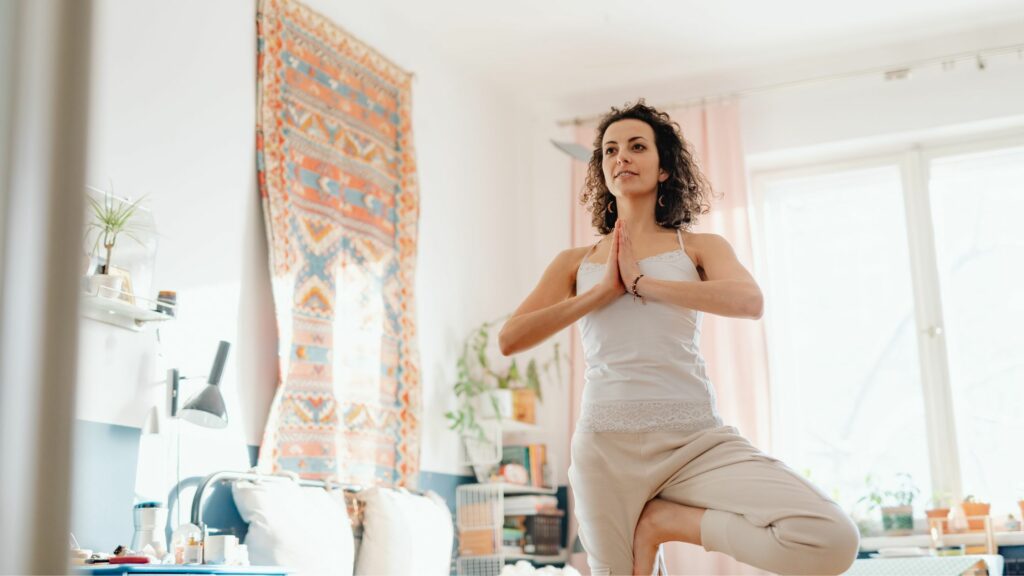
Movement, meditation and breathwork get you out of your head and body-focused. That’s why all three are essential for women with sleep problems in midlife.
This is how I suggest you use yoga for better sleep.
In the Daytime
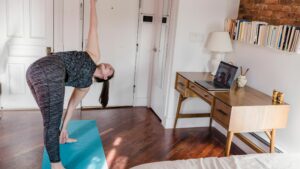
Start your day with movement.
Warm-ups
If morning exercise isn’t your thing, at least do some gentle warm-ups to loosen up your joints. Arm, leg and neck circles will all help with joint pain that may have settled in over the night.
Vinyasa
Lifting your heart rate during the day will encourage your body to take its rest at night. So try to fit in some vigorous practices – such as sun salutations and Vinyasa Flows – before the sun goes down.
Before Bed
Evenings are suited for more leisurely practices. Slowing down your movements encourages your thoughts to follow suit. Try a gentle Hatha or restorative practice with the lights low.
Restorative yoga is especially good for sleep, because you’re supported by piles of blankets, pillows and bolsters. Instead of “holding” each pose, you let go into the shape for five to 10 minutes. This letting go combined with the dark environment activates your parasympathetic nervous system – the one nicknamed “rest and digest”.
Restorative Yoga for Sleep
These are my top three favourite restorative poses before bed. I recommend covering yourself with a blanket, and using an eye mask or pillow. You want to feel as cozy as possible.
Supported bridge
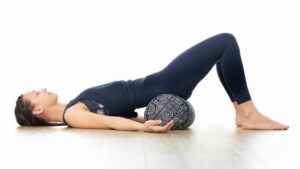
Use WAY more pillows than shown in this photo!
This gentle inversion and backbend is wonderful for releasing tension before bed.
Start by creating a “ramp” of pillows, with the high point under your hips, and the low point under your shoulders. You can also place a rolled up blanket under your neck to avoid it feeling crunched.
Legs up the wall

If you’re on your feet a lot or have varicose veins, this is a delicious pose. You’ll actually feel the lymph draining away from your feet.
Lie with your back on the floor, and extend your legs up the wall, hips as close to the wall as feels comfortable. Some people like a pillow under the sacrum.
If extending your legs is uncomfortable, lay on the floor with your calves and feet over the seat of a chair or the arms on your couch.
Try it for five to 10 minutes.
Reclined bound angle or butterfly pose. (Supta baddha konasana)
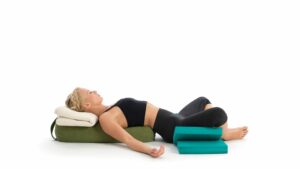
You’ll want a whole nest of pillows for this one. Basically, you’ll be starting in a seated butterfly and then reclining into a backrest of pillows with your thighs and feet.
All the supports allow your chest, abdomen, and hips to open gradually. Open your arms slightly to the sides, palms up, and resting on even more pillows or rolled up blankets.
Yoga Nidra
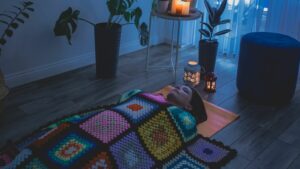
Yoga Nidra is the ultimate sleeping aid. Experts say that you’re supposed to remain conscious while your body and mind rest. I dare you to try! Most people find it impossible not to drift off.
Essentially, you listen as someone guides you to relax each part of your body over a period of 40 to 60 minutes. In this peaceful state, your pineal gland releases melatonin, the hormone responsible for sleep.
Don’t worry if you don’t fall asleep. One of the benefits of Yoga Nidra is that a 40-minute session of conscious relaxation is equivalent to a four-hour nap.
Meditation for Sleep
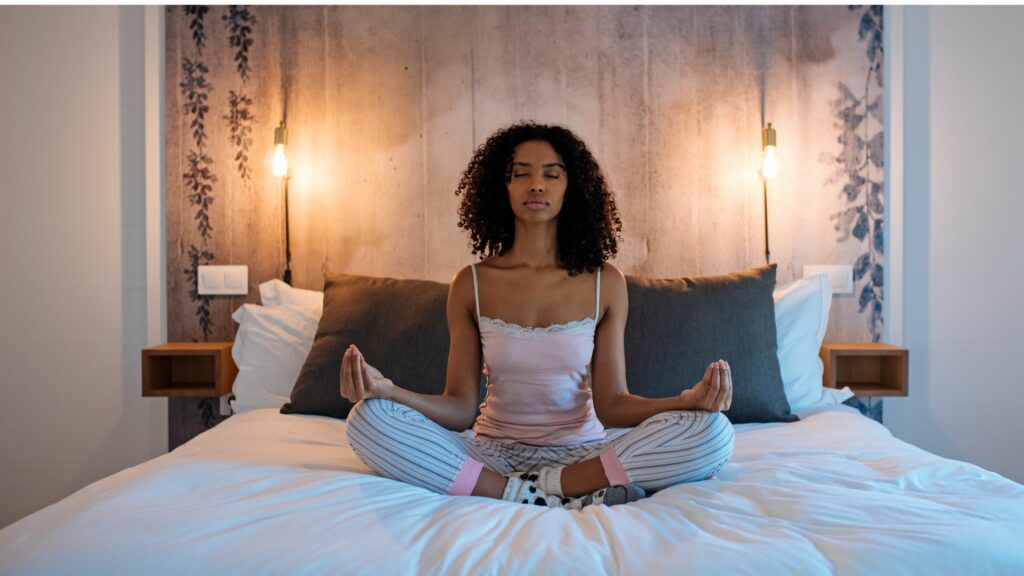
Meditation teaches your mind to focus on thoughts of your choice, like a mantra or how your breath feels as you exhale.
When you find yourself worrying about tomorrow’s errands, you can stop quickly and return to your focal point before you get wound up.
Some people include meditation in their bedtime routine. But the truth is that meditation will help you sleep better no matter what time of day you practice.
The effects of meditation are cumulative. The first time you try it, nothing much happens. But over time, you’ll notice that it’s easier and easier to concentrate.
Breathing Practices For Sleep
Breathwork is fabulous for improving sleep. It lowers your heart rate, reduces stress, and helps you focus on the present – three necessities for falling asleep.
Here are two I’d recommend before bed.
Box Breathing
This involves four even counts of 4 – hence the idea of drawing a box with your breath.
- Breathe in to a count of 4.
- Hold for 4.
- Breathe out to a count of 4
- Wait 4 counts before inhaling.
Repeat 3 to 10 times until you feel relaxed.
Alternate Nostril Breathing
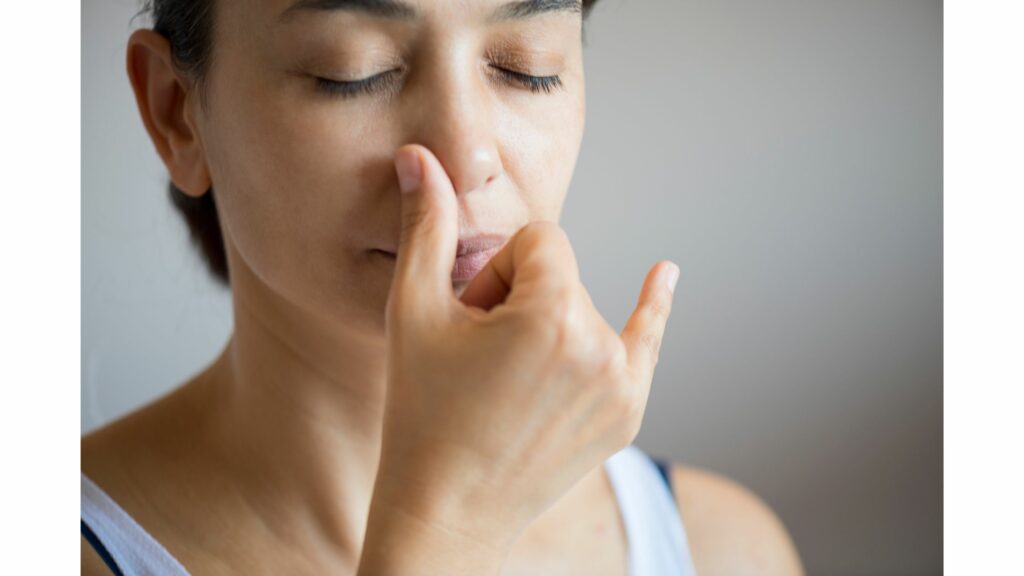
This one is a little more complicated, but excellent for re-balancing if you’re feeling off kilter.
- Exhale completely.
- Plug your left nostril, and breathe in slowly through the right.
- Release your left nostril, plug the right, and exhale slowly through the left.
- Inhale back through the left nostril.
- Release your right nostril, plug the left, and exhale completely through the right.
Repeat 3 to 10 times. Then sit quietly with your eyes closed, noticing any changes in your body or mood.
Sleeping Better in Midlife
There are a lot of exhausting sleep problems for women in our 40s, 50s, 60s and beyond. Hormones, body pains, depression, and weak bladders are challenging opponents.
Remember to prioritize my sleep tips for midlife women:
- Set up your room for sleep – dark, cold, and quiet.
- Reduce caffeine and alcohol.
- Cultivate a healthy routine of yoga, meditation, and pranayama.
And if you do find yourself on the couch again, flicking angrily through Netflix, remember to be kind to yourself and your body. Midlife women may be tired. But we are also strong, wise and resilient. After all, nothing has beaten us yet!
More tips for Yoga Routines
Do you want more tips and encouragement for setting up a yoga routine that works for you? Check out my membership program.
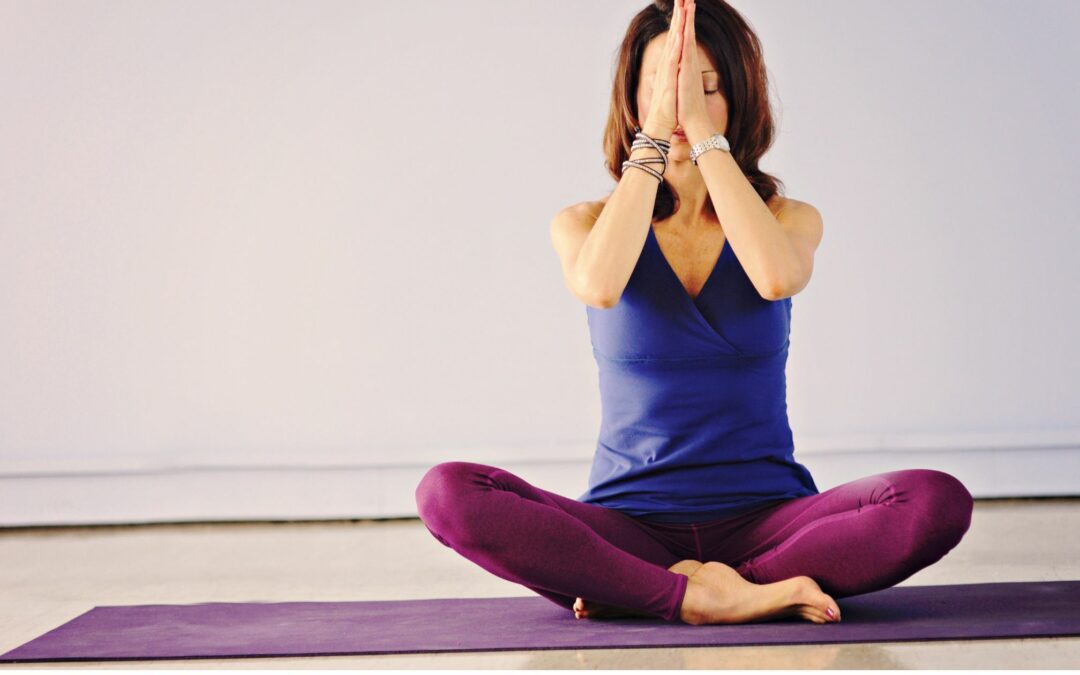
by Jo-Ann Brine | Menopause |
It’s supposed to be our time for aging gracefully. But how can we feel graceful when midlife brings symptoms like insomnia, weight gain, irritability, and joint pain? Read on to learn how yoga helps with menopause symptoms – the 10 most common.
Yoga Strengthens Bones

At every moment, cells in our bones are naturally deteriorating and regenerating. After menopause, the regrowth stage slows, so our bones start to lose density. This can lead to fractures, pain, loss of height, and even dowager’s hump (kyphosis).
How can yoga improve bone strength in perimenopause?
According to a 2016 study, six months of regular yoga was enough to improve bone density in women already suffering from osteoporosis.
How? Pressure stimulates bones to retain more of the calcium we get from food and supplements and slows the break-down part of the cycle, meaning we stop losing faster than we can rebuild.
We get this pressure from weight-bearing activities like running and walking. And yoga is even better, because it strengthens arm, spine and shoulder bones as well as legs.
Planks, side planks and crow poses all decrease your risk of fracturing arm or shoulder bones, while Warrior and Chair poses strengthen leg and foot bones.
Yoga Reduces Joint Pain
When estrogen levels drop after menopause, we can experience painful swelling in our joints, that sometimes turns into arthritis.
How does yoga help with joint pain?
When your joints hurt, you don’t feel like moving. But the less you move, the more joint pain increases.
Yoga is a great solution because movements are safe and gentle but still provide enough activity to make our joints feel better, and keep them operating in their full range.
Attend a full class a few times a week and do some gentle warm-ups like arm circles and leg lifts in between times to keep joints lubricated and moving in their full range.

Yoga Improves Sleep
Hands up…who’s having trouble sleeping?
40% of us struggle with terrible sleep in peri- and post-menopause. (Compared to only 12% before menopause). Blame the drop in estrogen and progesterone for insomnia, night sweats, restless legs, snoring and sleep apnea, and increased depression and anxiety.
How does yoga help with sleep?
A 2022 study found that yoga significantly improved sleep quality for post and perimenopausal women.
A regular yoga practice can make it easier to stick to healthy sleep routines.
Mindfulness practices increase melatonin which helps with going to sleep and sleeping more deeply.
And even the annoying symptoms of restless leg syndrome are shown to reduce in women who practiced yoga regularly for eight weeks.
And while yoga doesn’t stop night sweats, it can lessen the anxiety we feel about it. So when the hot flash is over, we get back to sleep more quickly.
Practice regulated breathing (pranayama) in bed, rather than let your mind run away into worries about tomorrow. Intentionally focus on a slower exhale to shift your body out of the sympathetic (fight or flight) function and into a parasympathetic (rest and digest) phase.
Yoga Helps Us Cope with Irritability
Irritability, sadness and mood swings are extremely common for women post-menopause. The drop in estrogen and progesterone can feel like constant PMS.
How does yoga help with irritability?
Focusing on sensations while we practice yoga actually enhances our ability to ride out waves of emotion in daily life. We get better at observing a situation and our emotional reaction without judgment.
For example, instead of shrieking at your family’s slobbiness, you might simply observe, “Seeing my family’s shoes and socks scattered around the entryway makes my heart beat really fast. My mind is filled with swear words. I feel like yelling. I’m experiencing rage about shoes.”
Then you get to choose between telling your family off now, or talking to them calmly after taking a brisk walk.

Yoga Supports Heart Health
After age 50, women’s risk of heart disease increases significantly. The good news is that women who get their hearts pumping by moving their bodies regularly have a lower chance of suffering from heart disease.
How does yoga help with heart health?
Yoga is a great option for those of us who don’t like the more obvious cardio exercises like running or team sports. Take a vinyasa class once a week. Or add a handful of sun salutations to your daily hatha practice.
Yoga improves heart health indirectly too. People who do yoga regularly are more likely to feel like engaging in other forms of exercise. A regular yoga class can also motivate you to eat healthier, quit smoking or cut down on alcohol intake.
Yoga Improves Balance
Of course, you know yoga helps with balance. Tree pose or Vrksasana is probably the most common image you’ll see if you search for yoga images online. But how does that relate to peri- and post-menopause?
Why Balance is Important after Menopause
Better balance prevents falls. And since falls can result in fractures for older women, balance is super important. So don’t skip Eagle and Tree just because they frustrate you. These poses help you keep your footing when pathways get icy or the dog rushes past you on the stairs.

Yoga Increases Esteem
Perimenopause and menopause can really kick you right in the esteem. Not only are you dealing with moodiness, exhaustion, weight gain, and hot flashes, but you may also feel embarrassed about these perfectly normal symptoms.
How does yoga improve self-esteem after menopause?
A regular yoga practice maintains your confidence in your physical abilities: “So what if you’ve gained a few pounds! You can hold a Warrior 3 longer than any of them!”
Meditation brings your perspective back to your own inner experience. Remember that how you perceive the world is more important than how the world perceives you.
Yoga Reduces Chronic Pain
Chronic pain is an unfortunate reality for many women in later life. Migraines, fibromyalgia, back pain or arthritis can really tarnish your golden years.
How does yoga help with pain?
Lack of sleep makes pain feel worse. Take the edge off with restorative practices or yoga nidra to support a more restful sleep.
Even on tough days, try to do a few gentle postures or movements to keep joints limber. On better days, you can engage in more active practices.
Meditation and pranayama will help you manage stress throughout the day – another factor that worsens pain.

Yoga Prevent Weight Gain
Gaining weight is one of the more common symptoms of aging. Hormone changes mean that we gain inches around our middles instead of our hips. We also lose overall muscle mass, which means that we aren’t burning as many calories as when we were younger. And if we’re sleeping poorly, we’re probably snacking more too.
How can yoga prevent weight gain after menopause?
Keeping up with your plank, boat and chair poses will help to maintain your calorie-burning muscle mass. Add in some morning vinyasas to get your heart pumping and some evening meditation to stave off snack-inducing insomnia.
Yoga Reduces Stress
Let’s be real. It’s not just hormones causing stress in mid-life.
We’re also juggling worries about careers, teenagers, aging parents, mortgage fluctuations, leaky roofs, a pandemic, inflation, climate change, the cat throwing up on the rug, and …what else you got?
How does yoga reduce stress in peri- and menopause?
Take a deep breath. And another. And another. This is what pranayama is for – reducing stress so we can focus on what really needs our attention.
Practicing pranayama regularly makes it more likely that you’ll reach for this technique when dealing with difficult traffic, difficult people, or difficult situations.
Just noticing your breath can be enough to slow your heart rate and your racing thoughts. Then you’ll be able to recognize which problems belong to you, and which belong to others.

Can Yoga Help with Menopause Symptoms?
The answer is a resounding YES!
Hormone changes in perimenopause and menopause can serve up a bumpy ride of physical, mental and emotional symptoms. But a regular yoga practice addresses all of them.
Asana supports bones, heart, joints, and balance, while reducing pain and limiting weight gain. Pranayama helps us cope with sleep loss and irritability. And meditation boosts our self-esteem, while providing a protective bubble that can insulate against stress and chronic pain.
If there’s a time for recognizing that yoga is a holistic system for supporting physical, emotional, and mental health, it’s definitely peri- and post-menopause.
Ready to Rock Your Way Through Midlife?
Join me in the Wellness Oasis for more learning and Midlife Health and Wellness. Or check out my upcoming 5-week Menopause Rest










































